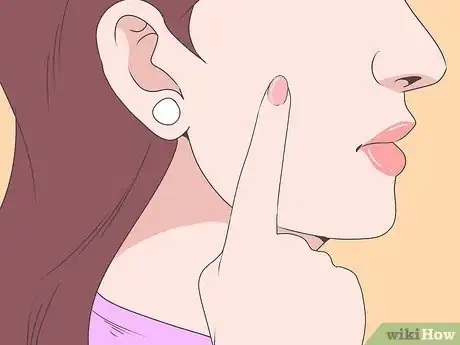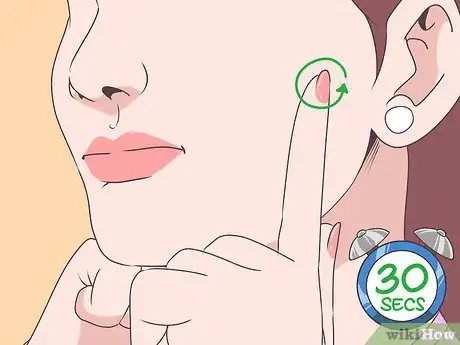This article was co-authored by Jonathan Stancato and by wikiHow staff writer, Christopher M. Osborne, PhD. Jonathan Stancato is a Holistic Voice Coach and the Founder of Inside Voice, an approach to improving one's voice and singing abilities through a mind-body 5-octave approach developed while he was working at the Royal Academy of Dramatic Art in London. He serves clients online and in-person in the New York City metro area and has taught students in theatre conservatories, music festivals, mindfulness organizations, TED Conferences, colleges, choirs, and corporations. Jonathan has extensive training in extended voice (Richard Armstrong/Roy Hart), Hindustani classical vocals (Michael Harrison), and trance singing (Thomas Richards/Grotowski Workcenter).
There are 12 references cited in this article, which can be found at the bottom of the page.
This article has been viewed 12,159 times.
Jaw tension is a common problem among singers that can make it really difficult to hit all the right notes. Fortunately, there are several options available for reducing jaw tension, most of which you can do quickly and easily on your own. Working with a vocal technique instructor and consulting with a medical professional can also help, so don't let jaw tension stop you from belting out your favorite tunes!
Steps
Doing Singing Exercises
-
1Practice in front of a mirror and observe yourself closely. While you can feel and hear the impact of a tense jaw while singing, it’s important to see your jaw in action in order to solve the problem. Recording yourself is one option, but practicing in a mirror gives you real-time feedback on your jaw positioning.[1]
- If your jaw looks like it's clamped shut or jutting out when you sing, jaw tension may be an issue for you. But, remember that this is something you can deal with!
- Especially if you’re a novice singer, jaw tension is often connected to anxiety about singing. Practicing in front of a mirror is a good way to get clear feedback in a low-stress environment.
- Try doing quick singing exercises, like those described in this section, once per day. This frequency helps you to build new habits without over-using your voice.
-
2Loosen your jaw with an easy smile and practice “ya” and “la” sounds. While looking in the mirror, form a slight smile—not a big, toothy grin!—and let your jaw naturally hang free. While maintaining a single pitch, go down a 5-note scale by alternating between singing “ya-ya-ya” and “la-la-la.”[2] Focus on keeping your jaw loose so that your tongue is doing the work in forming the sounds.[3]
- Repeat the exercise as many times as you like, adjusting the pitch as desired.
Advertisement -
3Press your finger to your chin and sing “ya-ya-ya” with a relaxed jaw. Touch your index finger to the middle of your chin. While keeping your head level, draw your chin back slightly, using your finger to hold it—not push it—back. Open your mouth and practice singing “ya-ya-ya,” keeping an eye on your jaw positioning and movement in the mirror.[4]
- This exercise helps remind you to keep your jaw from sticking out while singing. This is a common sign of jaw tension.
- Do not draw or push your jaw back so much that it causes pain or discomfort.
- Try doing this exercise for 10-15 seconds, 2-3 times or more.
-
4“Voice your breath” to help loosen the jaw muscles in your neck. Stand or sit up straight while looking in the mirror and breathe in deeply through your nose. As you breathe out slowly and fully through your mouth, create either a “huuuh” or “aaahh” sound with the escaping air. Repeat the process for 30-60 seconds.[5]
- “Voicing your breath” helps to isolate and loosen up the muscles in the back of your neck that control your upper jaw.[6]
-
5Make a slight chewing motion while singing your scales. Look in the mirror and pretend that you’re chewing on something soft—like a muffin, not a carrot! While continuing to pantomime a chewing motion, start singing your scales by alternating between “ya-ya-ya” and “la-la-la” again.
- This will feel awkward at first, and your “ya” and “la” sounds may come out a bit strange. This exercise helps you relax your jaw and utilize your tongue more in forming sounds, though.
-
6Lip-synch in the mirror and see if your jaw moves more freely. If you have trouble relaxing your jaw while singing, see if it’s easier to relax it while fake singing! It’s natural to be more demonstrative with your facial movements while lip-synching, so you’ll often find that your jaw relaxes naturally.[7]
- Lip-synching doesn’t require the same breath control as singing out loud, so it’s not an exact analogue. After lip-synching for a bit, try shifting to singing out loud in the middle of a song. This will help you to maintain the same relaxed jaw.
- Have some fun with this! Lip-synching can be a nice break from traditional singing exercises.
-
7Work with a vocal technique instructor for targeted guidance. You can catch a lot by practicing solo in the mirror, but nothing beats having an expert set of eyes observing you. Ask friends and colleagues for instructor recommendations, and find someone you’re comfortable working with. Take their advice to heart and use their recommendations to your advantage.[8]
- Jaw tension is a common problem, even among trained and experienced singers. A good vocal technique instructor should have lots of good advice for dealing with this issue. Together you can figure out what works best for you and really embrace your passion for singing!
Managing Jaw Tension
-
1Keep your teeth and tongue in low-tension positions throughout the day. If you keep your teeth clenched—or if you rest your tongue between your front teeth—during the day while watching TV, doing homework, etc., you’re likely adding to your jaw tension and soreness. Remind yourself throughout the day to adjust your teeth and tongue positioning—you may even want to set reminders on your phone! Focus on the following:[9]
- Keep your front teeth slightly separated—not quite wide enough to stick your tongue in between—and your lips lightly pressed closed.
- Rest your tongue against the roof of your mouth, right behind your top front teeth.
-
2Cut back on excessive clenching, grinding, and chewing both day and night. These activities prevent your jaw from resting loose and free, which builds tension in the joints and often leads to soreness. If you chew gum frequently throughout the day or have a habit of clamping down on a pencil, toothpick, or pipe, give yourself reminders to cut back on or eliminate these behaviors.[10]
- Clenching your teeth on a pencil, for example, can be a tough habit to break, but you can do it! Try replacing it with something more jaw-friendly, like squeezing a small stress ball in your hand.
- If you clench or grind your teeth at night while sleeping, talk to your doctor or dentist about treatment options, which may include a custom mouth guard.
-
3Adjust lifestyle choices (like drinking coffee) that may increase jaw tension. Activities that may seem completely unrelated to jaw tension may in fact be exacerbating the problem. Try cutting back on or cutting out any of the following that apply to you, and don’t be afraid to consult your doctor for guidance:[11]
- Consuming excessive amounts of caffeine. “Excessive” in this case equates to 6 or more cups of coffee per day.
- Drinking alcohol, especially if you have more than 1-2 drinks per day.
- Smoking.
- Using recreational drugs.
-
4Reduce your overall tension by using stress relief techniques. Jaw tension is often a sign of overall tension due to stress or anxiety. You might be nervous about singing, or be stressed out about things completely unrelated to singing. By managing your stress more effectively, you may be able to eliminate jaw tension when it’s time to sing.[12]
- For example, if yoga works well for you as a stress reducer, try doing a quick session before a singing practice or performance.
- Along with yoga, good stress-busters include meditation, deep breathing exercises, progressive muscle relaxation, visualization techniques, light exercise, walking in nature, talking to a good friend, and listening to soothing music. The important thing is to find what works best for you!
-
5Apply moist heat to both loosen and soothe a tight jaw. Soak 2 soft cloths in warm water, wring them out, and hold them up to your cheeks, about 1–1.5 in (2.5–3.8 cm) in front of your ears, for about 10-15 minutes. Try this before singing to help loosen your jaw muscles, and after singing if you experience jaw soreness or tightness.[13]
- You can repeat this technique as often as needed throughout the day.
- Soaking in a warm bath also helps, but it’s tough to soak your cheeks without putting your whole head under water!
-
6Speak to your dentist and/or doctor about ongoing problems. While jaw tension can be caused by poor singing technique or everyday stress, it can also occur due to more serious medical issues. If you aren’t seeing improvement on your own, make an appointment with your dentist, your doctor, or both. Treatment options might include, for example:[14]
- Using a custom-fitted mouth guard during the night.
- Undergoing dental procedures that may reduce jaw discomfort.
- Taking a muscle relaxant medication.
- Working with a mental health professional to reduce your stress.
- Getting tests done to check for other jaw disorders.
Massaging Your Jaw
-
1Touch your index fingers to the notches under your cheekbones. You’ll find each notch about 1–1.5 in (2.5–3.8 cm) in front of your ear and on the underside of the rear of your cheekbone. These notches are pressure points that give you access to your jaw’s masseter muscles.[15]
- Your masseters are not only your jaw’s most powerful muscles, they are, factoring for size, the most powerful muscles in your body.
-
2Press your index fingers firmly against the notches. Press in and slightly up with the tips of your fingers until you feel a soothing sensation that’s topped with an-ever-so-slight sensation of pain—basically, the feeling you look for in a good massage! Don’t press so hard that you experience outright pain.[16]
- If you aren’t able to press firmly enough to cause this sensation with your index fingertips, try using 2 fingertips per side, your thumbs, or the middle knuckles of your middle fingers.
-
3Knead the notch areas by making small circles for 30-60 seconds. Maintain steady pressure while you create small, even circles with your fingers, thumbs, or knuckles. If you prefer, stop making circles every 15 seconds or so and simply maintain steady pressure on the notches for about 5 seconds.[17]
- Try switching from clockwise to counterclockwise circles (or vice versa) halfway through your massage, if you wish.
- Do this quick massage before singing practice, before bed, when you wake up, and pretty much anytime your jaw feels tight!
Expert Q&A
-
QuestionHow can I release jaw tension while I'm warming up?
 Jonathan StancatoJonathan Stancato is a Holistic Voice Coach and the Founder of Inside Voice, an approach to improving one's voice and singing abilities through a mind-body 5-octave approach developed while he was working at the Royal Academy of Dramatic Art in London. He serves clients online and in-person in the New York City metro area and has taught students in theatre conservatories, music festivals, mindfulness organizations, TED Conferences, colleges, choirs, and corporations. Jonathan has extensive training in extended voice (Richard Armstrong/Roy Hart), Hindustani classical vocals (Michael Harrison), and trance singing (Thomas Richards/Grotowski Workcenter).
Jonathan StancatoJonathan Stancato is a Holistic Voice Coach and the Founder of Inside Voice, an approach to improving one's voice and singing abilities through a mind-body 5-octave approach developed while he was working at the Royal Academy of Dramatic Art in London. He serves clients online and in-person in the New York City metro area and has taught students in theatre conservatories, music festivals, mindfulness organizations, TED Conferences, colleges, choirs, and corporations. Jonathan has extensive training in extended voice (Richard Armstrong/Roy Hart), Hindustani classical vocals (Michael Harrison), and trance singing (Thomas Richards/Grotowski Workcenter).
Voice Coach Humming or holding a tone for a full exhale can help you loosen up and get your voice ready for a performance.
Humming or holding a tone for a full exhale can help you loosen up and get your voice ready for a performance.
Warnings
- Don’t overuse your jaw, either by singing or doing other activities. Limit your singing practices to once per day at most, and cut back on unnecessary chewing and teeth clenching.⧼thumbs_response⧽
References
- ↑ https://wonderofvoice.com/jaw-tension-fix-for-singers-release-your-sound/
- ↑ Jonathan Stancato. Voice Coach. Expert Interview. 31 March 2020.
- ↑ https://www.backstage.com/magazine/article/tension-enemy-singer-part-jaw-tension-9787/
- ↑ https://www.ellenrobinson.com/2018/11/14/relax-your-ja-a-a-aw/
- ↑ http://tedb.byu.edu/?page_id=5587
- ↑ Jonathan Stancato. Voice Coach. Expert Interview. 31 March 2020.
- ↑ https://youtu.be/fa4Ia-81sqY?t=135
- ↑ https://www.singwise.com/articles/throat-jaw-tongue-and-neck-muscle-tension-and-pain-during-singing-causes-and-solutions
- ↑ https://www.uofmhealth.org/health-library/hw209204
- ↑ https://www.uofmhealth.org/health-library/hw209204
- ↑ https://www.nhs.uk/conditions/teeth-grinding/
- ↑ https://wonderofvoice.com/jaw-tension-fix-for-singers-release-your-sound/
- ↑ https://www.practo.com/healthfeed/are-you-involuntarily-clenching-your-teeth-23523/post
- ↑ https://www.hopkinsmedicine.org/health/conditions-and-diseases/temporomandibular-disorder-tmd
- ↑ https://www.painscience.com/articles/spot-07-masseter.php
- ↑ https://www.painscience.com/articles/spot-07-masseter.php
- ↑ https://www.painscience.com/articles/spot-07-masseter.php











































































